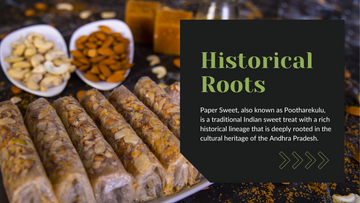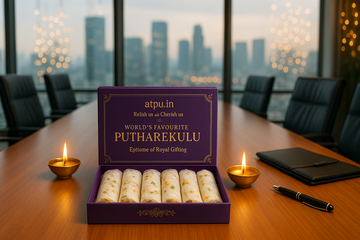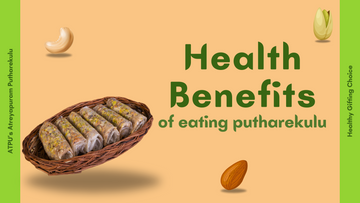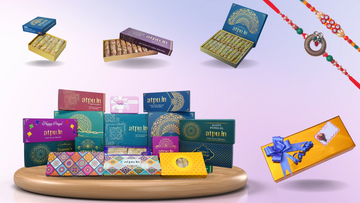
Paper Sweet, also known as Pootharekulu, is a traditional Indian sweet treat with a rich historical lineage that is deeply rooted in the cultural heritage of the Andhra Pradesh and Telangana regions. The origins of this delicate and intricate sweet can be traced back to the ancient Telugu kingdoms, where it was a celebrated delicacy served during festivals and special occasions.
The art of making paper sweets is believed to have been perfected by skilled confectioners in the royal kitchens of the Vijayanagara Empire, dating back to the 14th century. During this period, the empire was a major centre of cultural and culinary excellence, and the royal kitchens were renowned for their innovative and intricate cuisine. The use of rice flour and jaggery as the primary ingredients in paper sweets can be traced back to the agricultural practices and culinary traditions of the time. Ancient Telugu texts and manuscripts mention the existence of sweet treats similar to the modern-day Paper Sweet, indicating its deep-rooted history in the region.
As the art of making Paper Sweet was passed down through generations, it evolved and adapted to different regions' changing tastes and preferences. However, the core techniques and ingredients remained essentially unchanged, preserving the essence of this ancient culinary tradition. The intricate process of making Paper Sweet symbolises patience, dedication, and skill, reflecting the region's rich cultural heritage.
Overview of Paper Sweet - Pootharekulu
Paper sweet, also known as Pootharekulu in Telugu, is a traditional Indian sweet with roots in the Andhra Pradesh and Telangana regions. This delicate and intricate sweet is made from rice flour, jaggery, and other ingredients, resulting in a thin, translucent, and visually stunning treat.
The unique name "Paper Sweet" stems from its paper-thin and delicate appearance, achieved through an intricate process of rolling and flattening the sweet mixture. These delicate treats with vibrant colours of pistachios and jaggery make them visually appealing and a feast for the eyes.
Paper sweets in Hyderabad are a renowned delicacy. Skilled confectioners have perfected the art of making them for generations. In Hyderabad, paper sweets are often filled with a mixture of dry fruits and nuts, adding a crunchy texture and rich flavours.
The traditional Andhra Paper sweet recipe remains unchanged, but innovative variations have emerged, incorporating different flavours and fillings. In Bangalore, the paper sweet has gained popularity, and confectioners are reviving it with modern twists.
The paper sweet recipe involves a labour-intensive process that requires skilled hands and patience. The dough combines rice flour, jaggery, and other ingredients. These sheets are then cooked on a hot griddle, and the delicate sheets are carefully peeled off and stacked, creating a layered sweet.
Ancient Origins of Paper Sweet
The origins of paper sweets can be traced back to the ancient Telugu kingdoms, where they were a popular delicacy served during festivals and special occasions. The delicate sweets are believed to have been perfected by skilled confectioners in the royal kitchens of the Vijayanagara Empire. During this period, the Vijayanagara Empire was a major cultural and culinary excellence centre, and the royal kitchens were renowned for their innovative food dishes.
As the art of making Paper Sweet was passed down through generations, it evolved and adapted to different regions' changing tastes and preferences. However, the core techniques and ingredients remained largely unchanged, preserving the essence of this ancient culinary tradition.
The Paper Sweet's ancient origins and connection to the royal kitchens of the Vijayanagara Empire have contributed to its cultural significance and the reverence with which it is still regarded in the Andhra Pradesh and Telangana regions today.
Evolution of Paper Sweet
Over the centuries, paper sweets have evolved, adapting to changing tastes and preferences. While the traditional recipe remains largely unchanged, innovative variations have emerged, incorporating different flavours and fillings.
The humble Putharekulu, Hyderabad's paper-thin sweet, boasts a rich history. Traditionally, it was a simple yet satisfying treat made with rice flour, jaggery, dry fruits and ghee. Today, it's a canvas for creativity. Modern sweet shops offer a symphony of flavours alongside the classic recipe. From decadent dry fruits to playful options like Oreo and Horlicks, Putharekulu has embraced innovation while staying true to its roots. This evolution ensures its place as a beloved sweet for generations to come.
Traditional Methods of Preparation
The traditional preparation of paper sweets is labour-intensive and requires skilled hands and patience. The entire process demands attention to detail and expertise passed down through generations. Putharekulu's journey from batter to crispy delight involves a time-tested process:
- Soaked & Ground: Raw rice is soaked for hours, then ground into a smooth, thin batter.
- The Perfect Spread: A hot griddle or tawa spreads the batter evenly, creating a translucent sheet.
- Sweet Satisfaction: Jaggery or powdered sugar is sprinkled onto the cooked sheet for sweetness.
- Nutty Delight: A sprinkle of dry fruits and a drizzle of ghee add a layer of richness and texture.
- The Final Roll: The sheet is carefully rolled into a cylinder shape, ready to be enjoyed.
Cultural Significance
Paper sweets hold immense cultural and religious significance in the Andhra Pradesh and Telangana regions. They are integral to various festivals and celebrations, such as Diwali, Pongal, and weddings. The sweet is often a prasadam (offering) in temples and is considered auspicious. The intricate process of making paper sweets symbolises patience, dedication, and skill, reflecting the region's rich cultural heritage.
The sweet is a source of pride and identity for local communities, and its preparation has been passed down through generations, ensuring the preservation of this culinary tradition. Making and sharing Paper Sweet is a way to celebrate and maintain cultural bonds.
Influence on Other Cultures
This sweet's distinctive taste and visual appeal have transcended geographical boundaries, influencing other cultures and cuisines. In neighbouring states like Karnataka and Tamil Nadu, variations of Putharekulu have emerged, incorporating local ingredients and flavours. The intricate art of making these delicate sweets has caught the attention of confectioners worldwide, leading to the creation of similar delicacies in different cultures. This cross-cultural exchange showcases the universal appeal of these visually stunning treats and the ability of culinary traditions to inspire and influence others.
Legacy and Preservation
In recent years, there has been a concerted effort to preserve the legacy of putharekulu and ensure its continuity. Traditional sweet makers in Hyderabad and other cities have been recognised for their dedication to upholding authentic recipes and techniques. Culinary institutions and organisations have taken initiatives to document and promote the art of making Paper Sweet, ensuring this unique culinary tradition is passed on to future generations. Moreover, the revival of interest in Paper Sweet among the younger generation has helped sustain its legacy and cultural significance.
ConclusionThe historical roots of Paper Sweet are deeply intertwined with the rich cultural heritage of the Andhra Pradesh and Telangana regions. This delicate and visually stunning sweet has stood the test of time and transcended boundaries, influencing and inspiring culinary traditions worldwide.



